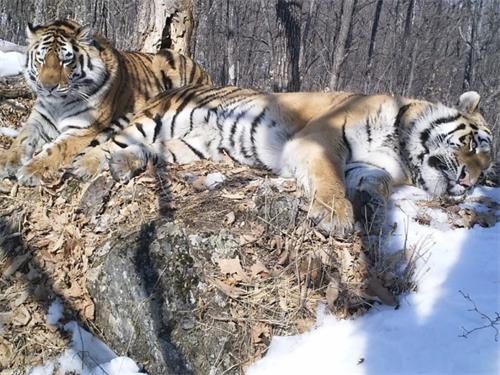
In Russia's Far East, the conservation of Amur tigers (also known as Siberian tigers) has achieved a surprising and heartwarming success. In 2012, researchers in the Sikhote-Alin Mountains discovered two orphaned Amur tiger cubs: a male named Boris and a female named Svetlaya. Although unrelated by blood, they shared a similar fate, both becoming orphans due to poaching. Scientists brought them to a rehabilitation center, providing an environment tailored for rewilding and eventual release into the wild. This intervention would set the stage for their extraordinary future.
Amur tigers were heavily targeted by poachers, particularly during the 20th century, when hunting and habitat destruction led to a drastic population decline. To protect this endangered species, scientists launched a rewilding program. This initiative was not only a rescue effort for orphaned tigers but also a crucial experiment in Amur tiger conservation. After spending 18 months at the rehabilitation center, Boris and Svetlaya completed their rewilding training.
Scientists released them separately along the Amur River, deliberately choosing release sites 200 kilometers apart to encourage the expansion of the tigers' territorial range. However, just months later, researchers were astonished to find that Boris had traveled the entire 200 km to reunite with Svetlaya. The two young tigers met again in the wild and eventually formed a family.
This remarkable story is not merely a coincidence but part of the broader success of the rewilding program. In recent years, as research has deepened, rewilding has become a cornerstone of Amur tiger conservation. In the past, orphaned tigers faced two bleak options: either spend their lives in captivity at a zoo or be released back into the wild to fend for themselves with little support. However, the rewilding program offers these cubs a better chance at survival. In an environment free from human interference, they learn essential survival skills by hunting small prey and gradually adapt to life in the wild.
A key feature of this program is ensuring that the tiger cubs retain natural behaviors. Before release, each tiger must pass a series of rigorous survival tests, including demonstrations of hunting proficiency. Food is provided remotely to prevent the tigers from associating humans with food sources. As the cubs mature, they gradually hunt larger prey, eventually matching the diet of wild Amur tigers. To prove they are capable of surviving independently, each tiger must successfully hunt at least 24 wild boars or sika deer.
Beyond training, the selection of release sites is crucial. Previously, scientists released tigers into territories already inhabited by humans or other tigers, but research has shown that introducing them to suitable but unoccupied land significantly expands their range. The Amur River region, once a prime habitat for these tigers, had seen their numbers dwindle due to poaching and habitat loss. By choosing this area for reintroduction, scientists not only provided the tigers with more space but also contributed to the recovery of the species in a region where they had nearly disappeared.
The results of this rewilding initiative are already visible. Except for one tiger that struggled to adapt and attacked livestock in a farmhouse, the rest successfully integrated into the wild. Even more encouraging, many of these tigers have found mates and started families, contributing to the recovery of the Amur tiger population. To date, out of six tigers released through the program, five have reproduced, giving birth to six cubs—a promising sign for the species’ population growth.
Among these successes, the reunion of Boris and Svetlaya stands out as the most symbolic. Their journey from orphaned cubs to wild parents is not only a testament to their resilience but also the culmination of years of dedicated effort by scientists. While these tigers may never realize the extent of human intervention behind their survival, their successful return to the wild brings new hope for the future of the Amur tiger population.

Paolo,Francesca
A Love Etched in the Soul: The Fated Romance of Paolo and Francesca
The story of Paolo and Francesca, though often imbued with a mythical aura, originates from a real and poignant tragedy. It is a tale of love, betrayal, and fate—filled with passion, suffering, and an inescapable destiny.

Sachiko,Mitsuo
A Forbidden Love: The Uncrossable Fate of Sachiko and Mitsuo
The love story of Sachiko and Mitsuo unfolds like a tragic melody, filled with pain, perseverance, and an everlasting bond.

The Barreleye Fish
Unveiling the Deep-Sea Mystery: How the Transparent Head of the Barreleye Fish Transforms Its Vision
The barreleye fish is a mysterious deep-sea species that inhabits depths of up to 2,500 meters. Its unique appearance and eye structure have long fascinated scientists.


